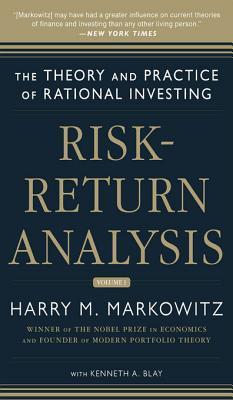What do you think?
Rate this book


The two most important words Harry Markowitz ever wrote are "portfolio selection." In 1952, when everyone in the stock market was looking for the next hot stock, as a doctoral candidate, he proposed to look at many, diverse stocks--a portfolio. He laid the first cornerstone of Modern Portfolio Theory and defended the idea that strategic asset growth means factoring in the risk of an investment. More than 60 years later, the father of modern finance revisits his original masterpiece, describes how his theory has developed, and proves the vitality of hisrisk-return analysis in the current global economy.
Risk-Return Analysis opens the door to agroundbreaking four-book series giving readers a privileged look at the personal reflections and current strategies of a luminary in finance. This first volume is Markowitz's response to what he calls the "Great Confusion" that spread when investors lost faith in the diversification benefits of MPT during the financial crisis of 2008. It demonstrates why MPT never became ineffective during the crisis, and how you can continue to reap the rewards of managed diversification into the future. Economists and financial advisors will benefit from the potent balance of theory and hard data on mean-variance analysis aimed at improving decision-making skills. Written for the academic and the practitioner withsome math skills (mostly high school algebra), this richly illustrated guide arms you
Concrete steps to accurately select and apply the right risk measures in a given circumstance Rare surveys of a half-century of literature covering the applicability of MPT Empirical data showing mean and riskmeasure used to maximize return in the long termGain perspective on the nanosecond trades, and see why the rational decision-making and probability beliefs of MPT still work. In a global market riding volatility, Risk-Return Analysis gives you the unflinching certainty you need to select your money making portfolio.
PRAISE FOR RISK-RETURN ANALYSIS
"Harry Markowitz invented portfolio analysis and presented the theory in his famous 1952 article and 1959 book. Nobody has greater insight into the process than Harry. No academic or practitioner can truly claim to understand portfolio analysis unless they have read this volume." -- Martin J. Gruber, Professor Emeritus and Scholar in Residence, Stern School of Business, New York University
"Surveying the vast literature inspired by [Markowitz's] own 1959 book has stimulated an outpouring of ideas. He builds on the strengths and limitations of the important papers in order to come up with a position that should silence a lot of critics." -- Jack Treynor, President, Treynor Capital Management
"The authors do not overlook various criticisms of the MPT, but rather address them convincingly. This excellent book is an essential reference for academics and practitioners alike." -- Haim Levy, Miles Robinson Professor of Finance, Hebrew University, Jerusalem, Israel
"Markowitz’s groundbreaking publications on Portfolio Selection prescribe a methodology that a rational decision-maker can follow to optimize his investment portfolio in a risky world. . . . Thischallenging new book clarifies many common misconceptions about modern portfolio theory." -- Roger C. Gibson, author of Asset Allocation and Chief Investment Officer, Gibson Capital, LLC
"Contain[s] great wisdom that every economist, portfolio manager, and investor should savor page by page." -- Andrew W. Lo, Charles E. and Susan T.
269 pages, Kindle Edition
First published January 1, 2013
It is planned that the current book will have four parts. At the suggestion of Frank Fabozzi, each part will be published separately when completed. ...
* Part I ... is concerned with the theory of rational decision making for single-period decision situations with known odds. It focuses on mean-variance approximations to expected utility. ...
* Part II ... will be concerned with rational decision making for the many-period game and its relationship to single-period utility maximization, still assuming known odds. ...
* Part III ... is with single- or many-period games with unknown odds. ...
* Part IV ... is concerned with additional application issues not addressed in the earlier parts of the book, especially the division of labor among data, theory, computation and the human. ...
This is clearly an ambitious program, especially considering that the undersigned is in his mid-eighties.